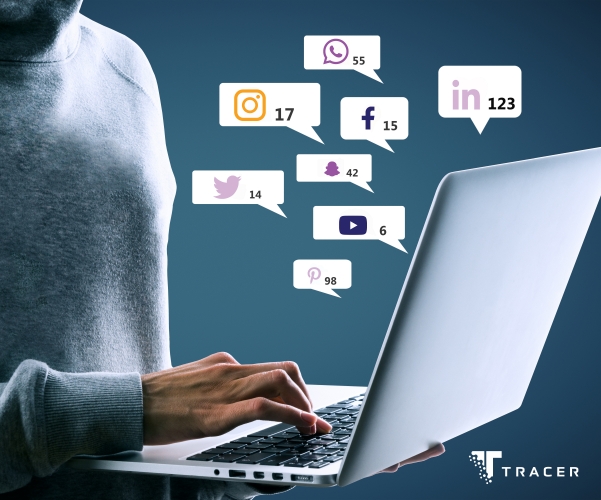How to Protect Your Brand on Social Media & the Digital Privacy of Your Customers
Social media is widely used by more than 4.62 billion people worldwide, making it a popular channel for businesses to interact with their customers. In fact, businesses are investing more than ever in social media. Due to its ever growing popularity, bad actors use these platforms, creating fake social media accounts to impersonate your digital products and services, costing you revenue and diminishing your brand’s reputation. In 2022 alone consumers in the United States lost $931 million to social media scams (approximately $3.4 million per day).
As social media usage continues to grow — and the scams along with it — knowing how to protect your brand on social media is more important than ever.

Common Types of Social Media Brand Abuse
Just as there is a plethora of social media apps, the types of social media brand abuse that occur is vast. From fake social media accounts, to counterfeits and merchandise scams, social media brand monitoring should cover the gamut.
1. Social Media Imposter Accounts
With minor changes to your account name, bad actors will create what appears to be a legitimate account. What your consumers don’t know is that they are stealing your legitimacy to infringe on their trust.
Example: Bad actors create a replica of your account, adding one character to the username, duplicating your website, and stealing your brand identifiers. Yes, that includes stealing your registered logo.
2. Phishing
There’s nothing like the irony of utilizing a fake account to gain access to a real one. Bad actors thrive off of this, creating social media imposter accounts to present as your legitimate brand and steal customer’s credentials.
Example: With a fake social media account, impostors directly comment and message your customers on social media. To gain extra “credibility,” they may reference real names of individuals who work at your business, all the while directing your customers to their scheme. From there, they will gather user credentials on a fake site and gain access to private accounts.
3. Job and Support Scams
Hiding behind your infringed brand, bad actors promise jobs and support. In reality, they are after the money and personal information of your consumers.
Example: You’ve worked hard to build your reputation as an employment search firm. But, in one quick motion, bad actors infringe on your brand. They pose as your brand and lure in your customers, promising support in recruitment. They may even have multiple meetings, building “trust” with the customer. Yet once the payment posts, they are nowhere to be found. Taking away your customer trust and their money.
4. Counterfeits
Counterfeit products cost brands over $500 billion per year. Sophisticated bad actors not only manufacture and distribute fake products, but leverage online marketplaces, paid search and advertising, social media and domains and websites for the promotion of these fake products.
Example: The perfect product. From design to functionality it perfectly answers your customer’s needs. What took you years to perfect, takes bad actors days to reproduce. That’s right, “real” products produced with “similar” materials posed to be sold under your brand. And it came from a social media ad with your logo and name — how couldn’t it be true? Listed at half the cost your customer’s think they are getting a steal. But the only thing stolen is your legal property and their trust.
5. E-commerce and Merchandise Scams
Free and easy to post on, bad actors utilize social media platforms to impersonate your digital products and services, costing you revenue and incurring significant costs in supporting your customers who’ve become victims.
Example: Products listed at a quarter of the price, your logo and name in the bio, a working social media storefront. Bad actors draw in your customers with all of these, cashing in on fake “products” sold and leaving your customer with nothing but an empty bank account.
Three Steps to Protect Your Brand on Social Media
While the number of scams may seem impossible to find and remove, you can take proactive steps in defending against, detecting, and eliminating bad actors — and it doesn’t have to be done alone.
1. Purchase Brand Identifiers
Before you can protect your brand on social media, you have to legally own the words that make it. By trademarking your name, products, and brand identifiers, you will have the legal basis you need to protect and enforce your brand across the digital landscape.
In addition to your trademarks, proactively purchasing domain variations of those brand identifiers eliminates the ability for bad actors to create imposter websites. This weakens false authority and their ability to sell your services online.
2. Set Up Your Social Media Accounts
Connecting all your brand elements to your social media account adds another layer of authority. Carefully consider what you name your account, utilizing the brand identifiers and trademarks you own.
In setting up the account, be sure to cross link other accounts and your website. If you do have other accounts, be consistent in how your brand is presenting itself. The more consistency and cross sharing you have, the easier it is for your customers to pick out the fakes.
If the Twitter paid verification fiasco taught us anything, it’s how important that little blue check can be in determining legitimate accounts. Apply for this verification mark across your accounts for another layer of protection for your consumers.
Finally, if you do sell products, consider bridging into social media commerce. Setting up your social media storefront allows your customers to shop without ever leaving the app — adding another layer of authenticity and identification against bad actors.
3. Monitor and Enforce Your Brand
Customers need to feel assured that every interaction with your brand is real. By constantly monitoring, accurately detecting, and efficiently eliminating you will preserve authentic customer interactions. Automated and AI informed social media brand monitoring enables you to quickly detect instances of misuse.
By automating the detection of infringing content, the classification of infringements, the correlation of incidents and bad actor networks, and the enforcement of customer directives, you can not only take down the abuse, but utilize dynamic market insights to fuel better business decisions.

Protect Your Brand with Agility and Speed
Your brand’s success can be directly tied to upholding an authentic experience for your customers. With $770 million reported in social media fraud loss, the risks from fake social media accounts is more present than ever.
But, learning how to protect your brand on social media doesn’t have to be done alone. Through Tracer’s automated brand protection, you can continuously trace, analyze, and prevent brand abuse across social media platforms. Tracer allows customers to define and customize detection criteria, deploy machine learning models to fit unique brand directives, and create enforcement rules that can be automated for scale.
Author


